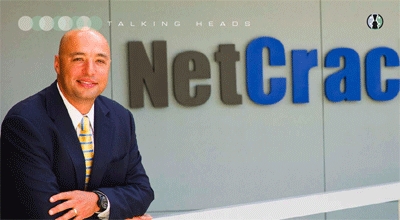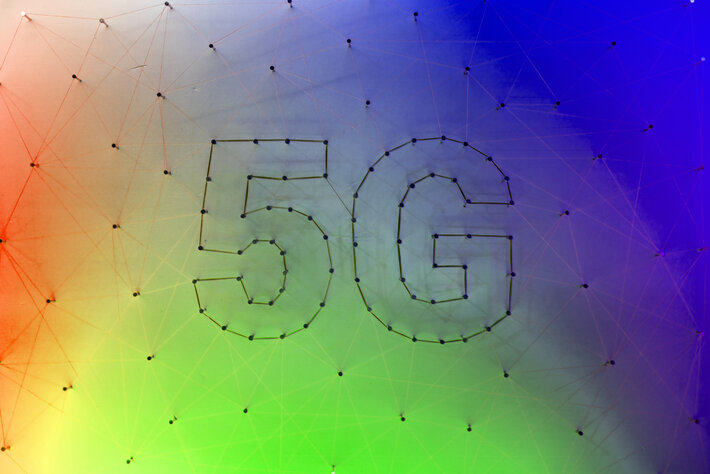An unusual go-to-market strategy from the start, zero borrowings, and consistent profitability are enough by themselves to mark out NetCracker among telecom ISVs of the last two decades. But throw in the extraordinary backing of Japanese technology giant and parent company, NEC and you have an intriguing story from a still-bullish CEO.

Andrew Feinberg, President and CEO of NetCracker Technology
An unusual go-to-market strategy from the start, zero borrowings, and consistent profitability are enough by themselves to mark out NetCracker among telecom ISVs of the last two decades. But throw in the extraordinary backing of Japanese technology giant and parent company, NEC and you have an intriguing story from a still-bullish CEO.
Andrew Feinberg is President and CEO of NetCracker Technology where he shapes the company’s corporate strategy and worldwide operations. Under him, NetCracker has grown to a leading position in Telecom Operations and Management Systems (TOMS), with customers in over 40 countries. NetCracker was acquired by NEC Corporation in 2008, and since then he has assumed a global leadership role for NEC, including responsibility for a multibillion dollar services and software expansion. He holds a B.S. from Bentley University and an MBA from the Wharton School, University of Pennsylvania.
VanillaPlus: What was NetCracker’s history and development prior to the 2008 merger with NEC? Was it organic?
Andrew Feinberg: NetCracker started in 1993 with a vision that customers would evolve from network or access providers to service providers, the technology would move to IP and NGN, that IT and networks would converge, and that business and operational software solutions would be at the core of that transformation.
To that vision we added some innovation, creating the architecture for a flexible, scalable, end-to-end footprint, and finally we created a winning business model, delivering success through best products and complimentary services. All our growth (and there were years when we were more than doubling in size) was organic. The fact that we never raised any venture capital kept us extremely focused on flawless execution as, quite frankly, we really could not afford to make mistakes or pay for failures.
We worked very closely with our customers to do whatever was needed to get the job done and that dedication, and eventually our successful track record, earned us a strong reputation in the industry. We re-invested every penny into the business as we continued to grow. Most importantly perhaps, we attracted some of the most talented people around the world who are still with us and continue to make us successful.
VP: Most independent systems vendors pursue a sales strategy that starts with Tier 2 and 3 communication service providers (CSPs). But that isn’t how you did it, is it?
AF: Well, it’s not like we entirely skipped that stage and I would never dismiss the contribution that Tier 2 and 3 players made to NetCracker along the way, as well as to the telecommunication industry as a whole. Many of those players brought to market some new, powerful services, great technologies and innovative business models. Having said that, the world of Tier 1 is very different from the world of smaller players. To be a successful partner to a Tier 1 carrier one needs to accomplish two very difficult objectives, and this would come as no surprise to you. We needed to scale the technology and the organisation. We knew this from Day One, and made no compromises in achieving and investing in those two objectives. We invested heavily so that we’d have a carrier-class application, both from a software architecture and a functionality standpoint.
We were early adopters of web technologies and adamant supporters of open architecture. We knew that carriers needed flexible and modular solutions, and designed our products that way from the beginning. We also understood the performance demands that carriers faced, and invested to make sure that our solutions could scale to meet those demands.
It sounds very obvious to you and me today, but remember this was a decade ago when everyone was promoting ‘plug and play’ architecture and it was very fashionable to have hundreds of best of breed products in an OSS / BSS footprint.
Finally, and equally importantly, we went against every conventional wisdom of the time and insisted on delivering our products ourselves. Remember, these were the times when ISVs were supposed to be invisible creatures sitting behind system integrators. We believed, however, that working closely with our customers would help us ensure successful implementations as well as understand the true needs, both now and in the future. This highly unusual decision – whilst it made us very unpopular with a number of SIs in the market – earned us a 100% successful implementation track record. And, just like with our products, we invested heavily in our solution delivery capabilities along the way to make sure that we built a scalable and efficient organisation.
VP: You say that it made you unpopular with SIs at the time; are these fences that you have mended since?
AF: We have, and it’s fair to say that we’ve worked with every system integrator around the world, and worked with them very successfully. However, our strategy has always been to look at our customer as the centre of the universe, and to work within the eco-system that is important to that customer. We never deployed a strategy that many other vendors in the industry did, which is to bet on a particular system integrator as a sales and delivery channel.
VP: You’ve talked publicly before about the different nature of your business model. You are, to use the jargon, a ‘boot-strapped’ company. Can you explain for those not familiar with the term what you mean by that, and how you differ from your competitors?
AF: Boot-strapping simply means that we never raised capital, so we always had to remain profitable, and we always made sure that our implementations were successful and delivered a return on investment to us and – just as importantly – to our customers. Our core values remained the same for almost two decades. Since the very early days we had five priorities:
- Our customers, where we focus on delivering quantifiable results and value, and becoming a trusted strategic partner
- Our technology, where we invest in the framework, applications, and solutions to maintain technological leadership
- Our people, where we focus on growing, supporting, and investing in what we call the best IT network solutions workforce in the world
- Financial results, coming back to our bootstrapped mentality, where we continue to grow the business while always ensuring profitability
- Infrastructure, where we invest in training, processes, systems, and facilities to sustain our high growth rate on a global basis
So, this has been our mantra for many years, and whatever we do, we come back to these five core values.
VP: We now come to the fascinating moment when the deal came about with NEC. How did it first appear to you and what were the drivers that made it happen, particularly when it did?
AF: Well, the few years prior to the NEC merger were extremely productive for NetCracker; we maintained a remarkable growth rate and profitability. At that point, Jeremy, we started looking at various growth options to satisfy demand for our solutions while maintaining our autonomy. We kept coming back to our core values and testing every option against them. Let me remind you that NEC is a global entity with US$40 billion in annual revenues and over $3 billion of annual commitment to R&D. So, conducting that test told us that merging with NEC was the right strategy for us to accelerate our growth, gain access to other innovative technologies, increase our solution footprint, and gain access to additional sales channels and delivery resources.
Now, two years later looking back, we can say that the merger enabled us to expand in all of those areas and solidify our position as market leader in the industry.
VP: You say market leadership, how do you assess that?
AF: That’s a very good question. I guess there are many ways of looking at leadership. To me a lot of this comes down to our customers, to brand recognition, and the reputation we enjoy around the globe. I don’t think there are many telecoms people today in North America and Europe – and increasingly in Asia, the Middle East and Latin America – who do not know what NetCracker does. The NetCracker name is synonymous with results, with delivering, with going an extra mile to make the customer successful. That to me is probably the most important, if intangible, measure of leadership.
But then you look at the quantitative results on revenues and the size of portfolio that you bring to market, you look at thought leadership and innovation, as well as investment that you make into future technologies. As we look at all these factors, I truly believe that NetCracker now – with the gigantic and highly innovative parent sitting behind us and supporting every move we make – has achieved that industry leadership.
VP: Why was NetCracker so important to NEC?
AF: NEC is a very large company with a strong brand recognition in a number of areas, but is primarily known for its hardware (both Network and IT) and its strong position in the Japanese market.
Around the time of the acquisition NEC went to market with a strategy of moving more towards the solution space from the pure hardware space, as well as to become a dominant global player with diversified holdings outside Japan. So, NEC looked at NetCracker as a strong agent to help it achieve those objectives, with our solution approach that combines software and services, and our global footprint where we had a significant customer base that was well diversified, not only from the type of customer standpoint (be they Tier 1 carriers, wireless, alternative operators, utilities, cable companies, etc.) but also geographically.
NEC clearly saw NetCracker not only as a channel outside Japan, and a significant move to the solutions business, but potentially as a strong transformational agent that would enable NEC to accelerate the execution of that strategy. We always talked (with NEC) of bringing key assets outside of Japan. Over time, following the acquisition (of NetCracker) we started executing this. Finally, in February this year we announced a major transfer of assets that included an end-to-end TOMS footprint, assets valued in billions of dollars under the NetCracker umbrella. That action was driven by our customers.
NetCracker has been involved in the largest number of transformational programmes in the industry. Given our successful track record and the fact that communication service providers are constantly looking to become more efficient and consolidate their supplier base, we were constantly being asked to offer a broader application footprint and end-to-end services portfolio.
NEC recognised that NetCracker brand awareness and customer loyalty is very high, and that it made most sense to drive our success. So those assets that included applications, product and service platforms, as well as services were consolidated under NetCracker.
VP: Where does NetCracker go from here?
AF: This is a remarkably exciting time for the company, as well as for me personally to be heading up NetCracker. The conventional notion of communication providers and devices is undergoing a fundamental shift. CSPs have gone from being basic connectivity providers to entities that store, process, and manage information. They’ve gone from being phone companies to entities that enable mobile commerce and transactions. NetCracker sits at the brink of this innovation, as our solutions enable CSPs to find ways to help drive new revenue and business models. As we leverage the additional resources and continue to build out this expanded footprint, we will continue to nurture the values that have made our company a success. We will remain 100% committed to our customers, and we will continue to have the same results-focused entrepreneurial culture that we have always had. So, despite the new responsibilities and bells and whistles that come with this large-scale expansion, we are the same NetCracker.
VanillaPlus: Innovative thinking from NetCracker leads to dramatic TOMS growth






